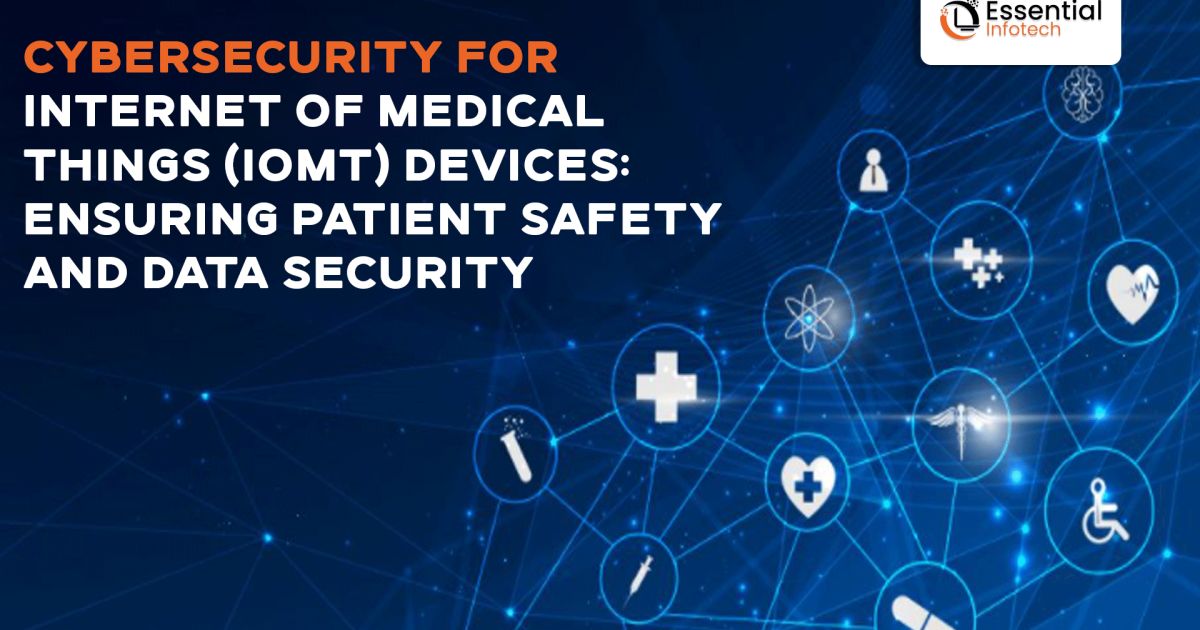

Cybersecurity for Internet of Medical Things (IoMT) Devices: Ensuring Patient Safety and Data Security
By linking wearables, sensors, and medical devices to the internet, the Internet of Medical Things (IoMT) has completely changed the healthcare industry by enabling real-time data collection, remote patient monitoring, and individualized treatment. IoMT devices have a great deal to offer in terms of bettering patient outcomes and the effectiveness of healthcare, but they also pose special cybersecurity difficulties that raise questions regarding patient safety and data security. Let's examine the significance of cybersecurity for Internet of Medical Things (IoMT) devices and discuss methods to reduce risks and protect patient data.
1. Unique Cybersecurity Challenges in IoMT Devices
a. Cyber Attack Vulnerability: Internet of Medical Things (IoMT) equipment, such as insulin pumps, pacemakers, and remote monitoring systems, are susceptible to cyberattacks that may jeopardize patient privacy and safety. Threat actors can obtain unauthorized access, change settings, or intercept private medical data by taking advantage of flaws in cloud-connected infrastructure, wireless communication protocols, or device software.
b. Risks to Patient Safety: Cybersecurity lapses in IoMT devices might result in potentially fatal outcomes, like manipulating medication delivery systems, changing medical records, or interfering with essential medical procedures. IoMT device malware presents serious threats to patient safety and wellbeing, thus strong cybersecurity safeguards are required to stop negative outcomes and safeguard patient health.
2. Strategies for Securing IoMT Devices
a. Risk Assessment and Vulnerability Management: To detect and reduce security threats related to IoMT devices, healthcare institutions need to carry out thorough risk assessments and vulnerability scans. The integrity, confidentiality, and availability of medical data must be guaranteed, and vulnerabilities must be fixed through routine security audits, penetration tests, and software patches.
b. Secure Device Design and Development: To create robust and tamper-resistant products, IoMT device manufacturers need to give security top priority during the design, development, and testing stages. Access controls, encryption standards, and safe coding techniques can all be used to stop illegal access, data manipulation, and the exploitation of security holes in devices.
c. Network Segmentation and Access restrictions: To isolate IoMT devices from other systems and reduce exposure to potential cyber risks, healthcare networks should put in place network segmentation and access restrictions. Attackers can't travel laterally when network traffic is segmented, least privilege access is enforced, firewalls and intrusion detection systems are put in place, and security incidents are lessened.
3. Regulatory Compliance and Data Privacy
a. Adherence to Regulatory Standards: In order to safeguard patient health information and guarantee data privacy and security, healthcare institutions must abide by regulations such as GDPR (General Data Protection Regulation) and HIPAA (Health Insurance Portability and Accountability Act). Sensitive medical data is protected and regulatory compliance is maintained through the use of encryption, access limits, and audit trails.
b. Data Encryption and Confidentiality: To protect data confidentiality and stop unwanted access, encryption is necessary for data transferred between IoMT devices, cloud servers, and healthcare systems. Patient health information is protected and the danger of data breaches is reduced by implementing strong encryption methods, secure authentication procedures, and data encryption both in transit and at rest.
Conclusion
In order to safeguard patient privacy and safety in healthcare settings, cybersecurity is essential to the safe and secure operation of Internet of Medical Things (IoMT) devices. Healthcare companies can reduce the risks associated with IoMT devices and promote trust in digital healthcare technology by tackling specific cybersecurity concerns, putting strong security measures in place, and adhering to regulatory regulations. Building a robust and secure healthcare ecosystem that puts patient safety and data protection first requires investing in cybersecurity awareness, training, and coordination among stakeholders.
Keep up with the most recent developments and recommended practices for IoMT device cybersecurity. See more posts on data privacy, medical device security, and cybersecurity in healthcare by visiting our blog.
We Are A Leading IT Company Experienced In Creative And Innovative Development And Design Solutions .